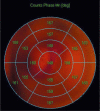Useful assessment of myocardial viability and dyssynchrony from gated perfusion scintigraphy for better qualification for resynchronization therapy. Part 3
- PMID: 33014092
- PMCID: PMC7526492
- DOI: 10.5114/kitp.2020.99080
Useful assessment of myocardial viability and dyssynchrony from gated perfusion scintigraphy for better qualification for resynchronization therapy. Part 3
Abstract
The first part of the review concerning myocardial imaging by single photon emission computed tomography (SPECT) discussed the basic aspects of interpretation of left ventricular perfusion disorders in stress and rest examination. The second part presented the interpretation of gated SPECT imaging in relation to the assessment of systolic and diastolic left ventricular functions. The third part concerns the assessment of myocardial viability and phase analysis from gated SPECT in the qualification of patients with left ventricular systolic dysfunction for cardiac resynchronization therapy.
W pierwszej części cyklu prac dotyczących scyntygrafii perfuzyjnej mięśnia sercowego metodą tomografii emisyjnej pojedyn- czego fotonu (SPECT) omówiono podstawowe zagadnienia na temat interpretacji zaburzeń perfuzji lewej komory w rejestracji wysiłkowej i spoczynkowej. W drugiej części przedstawiono interpretacje badania bramkowanego zapisem elektrokardiograficznym (GATED-SPECT) w odniesieniu do oceny funkcji skurczowej i rozkurczowej lewej komory. Trzecia część została poświęcona ocenie żywotności mięśnia sercowego oraz analizie fazowej badania bramkowanego w kwalifikacji pacjentów z dysfunkcją skurczową lewej komory do terapii resynchronizującej.
Keywords: GATED-SPECT; myocardial viability; phase analysis.
Copyright © 2020 Polish Society of Cardiothoracic Surgeons (Polskie Towarzystwo KardioTorakochirurgów) and the editors of the Polish Journal of Cardio-Thoracic Surgery (Kardiochirurgia i Torakochirurgia Polska).
Conflict of interest statement
The authors report no conflict of interest.
Figures







Similar articles
-
Reference values for left ventricular systolic synchrony according to phase analysis of ECG-gated myocardial perfusion SPECT.Clin Physiol Funct Imaging. 2018 Jan;38(1):38-45. doi: 10.1111/cpf.12379. Epub 2016 Jul 24. Clin Physiol Funct Imaging. 2018. PMID: 27453042
-
Myocardial perfusion scintigraphy - interpretation of gated imaging. Part 2.Kardiochir Torakochirurgia Pol. 2018 Mar;15(1):49-56. doi: 10.5114/kitp.2018.74676. Epub 2018 Mar 28. Kardiochir Torakochirurgia Pol. 2018. PMID: 29681962 Free PMC article. Review.
-
Left ventricular systolic and diastolic dyssynchrony assessed by phase analysis of gated SPECT myocardial perfusion imaging: a comparison with speckle tracking echocardiography.Ann Nucl Med. 2013 Oct;27(8):764-71. doi: 10.1007/s12149-013-0744-2. Epub 2013 Jun 18. Ann Nucl Med. 2013. PMID: 23775229
-
Evaluation of left ventricular mechanical dyssynchrony as determined by phase analysis of ECG-gated SPECT myocardial perfusion imaging in patients with left ventricular dysfunction and conduction disturbances.J Nucl Cardiol. 2007 May-Jun;14(3):298-307. doi: 10.1016/j.nuclcard.2007.01.041. Epub 2007 Apr 18. J Nucl Cardiol. 2007. PMID: 17556163
-
[Role of perfusion myocardial scintigraphy with gated SPECT technique in the diagnostic and prognostic evaluation of patients with chronic coronary disease].Ital Heart J Suppl. 2002 Mar;3(3):309-18. Ital Heart J Suppl. 2002. PMID: 12040846 Review. Italian.
Cited by
-
Left ventricular mechanical dyssynchrony after chemotherapy in breast cancer patients with normal rest gated SPECT-MPI.Ann Nucl Med. 2024 Apr;38(4):272-277. doi: 10.1007/s12149-023-01897-y. Epub 2024 Jan 20. Ann Nucl Med. 2024. PMID: 38244106
-
The assessment of left ventricular mechanical dyssynchrony from gated 99mTc-tetrofosmin SPECT and gated 18F-FDG PET by QGS: a comparative study.J Nucl Cardiol. 2022 Oct;29(5):2350-2360. doi: 10.1007/s12350-021-02737-0. Epub 2021 Jul 19. J Nucl Cardiol. 2022. PMID: 34282536 Free PMC article.
References
-
- Ponikowski P, Voors AA, Anker SD, et al. ; 2016 ESC Guidelines for the diagnosis and treatment of acute and chronic heart failure: The TaskForce for the diagnosis and treatment of acute and chronic heart failure of the European Society of Cardiology (ESC). Developed with the special contribution of the Heart Failure Association (HFA) of the ESC. Eur J Heart Fail 2016; 18: 891-975. - PubMed
-
- Petretta M, Storto G, Acampa W, et al. . Relation between wall thickening on gated perfusion SPECT and functional recovery after coronary revascularization in patients with previous myocardial infarction. Eur J Nucl Med Mol Imaging 2004; 31: 1599-1605. - PubMed
Publication types
LinkOut - more resources
Full Text Sources
